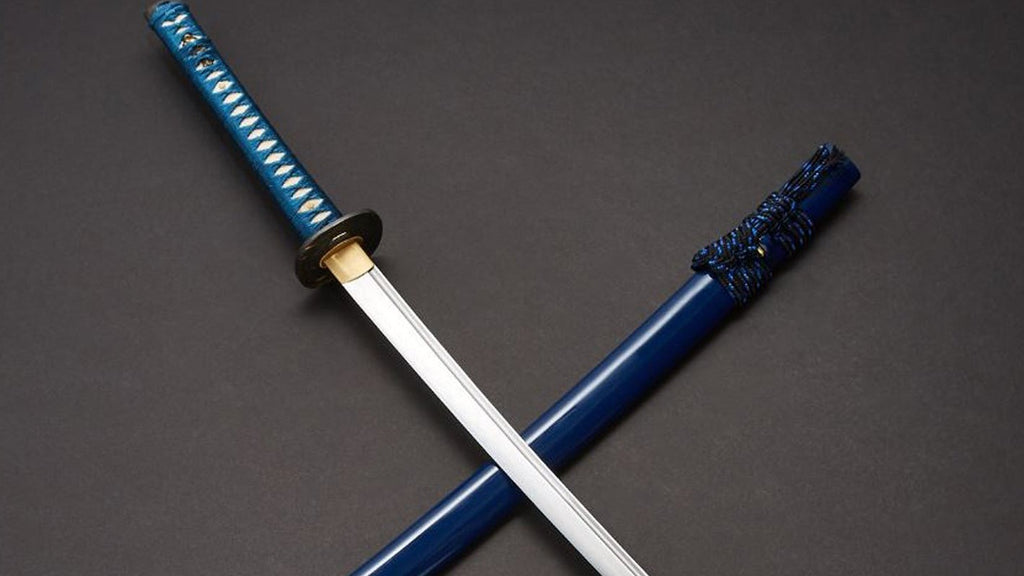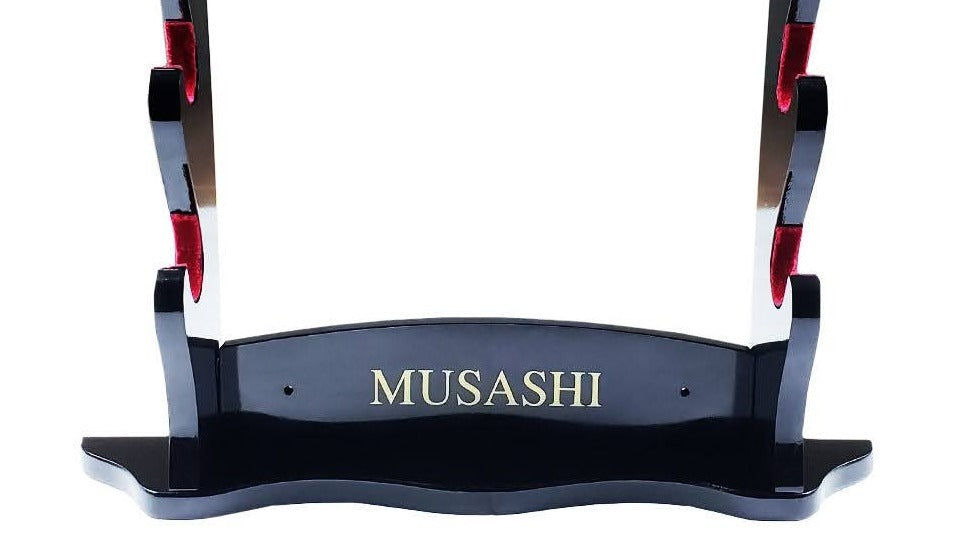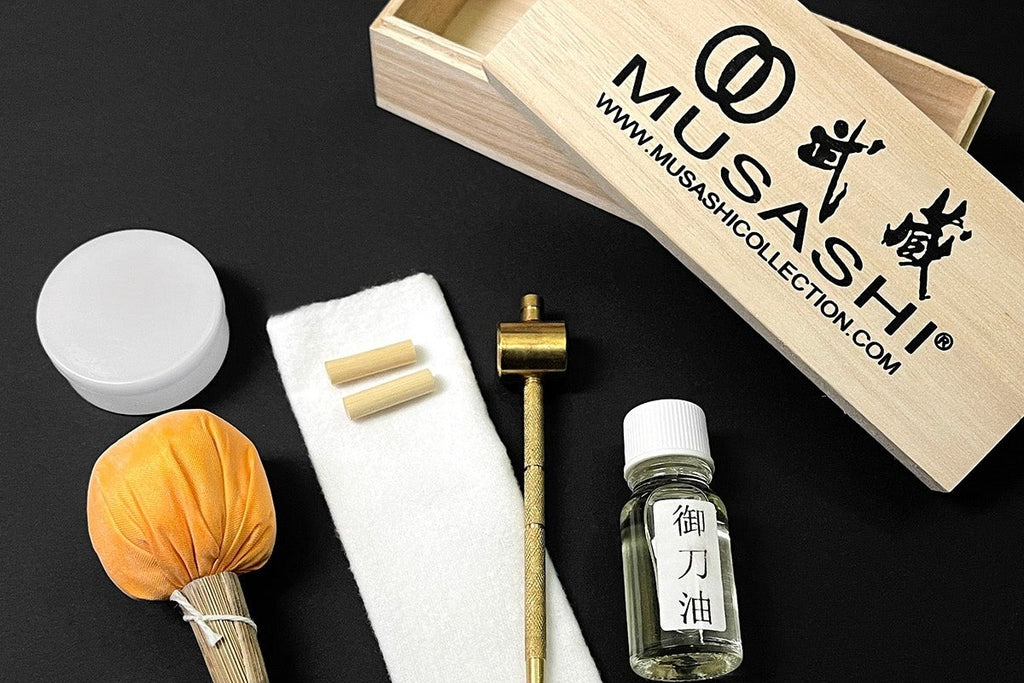
Owning a katana is not merely about possessing a piece of history; it's about embracing a culture, an art form, and a responsibility. Imagine the awe and slight intimidation felt when bringing home a first katana. This beautifully crafted sword, now a personal treasure, necessitates careful stewardship.
It becomes clear that maintaining a katana is more complex than one might initially think. This realization sparks a journey of learning and appreciation for the weapon and the art of keeping it in prime condition.
This blog post is the perfect resource for those passionate about their katanas but who need help keeping them safe and well-maintained when not in use. From selecting the appropriate katana stand to understanding the nuances of katana maintenance, everything needed to ensure this cherished sword remains in excellent condition for years is thoroughly covered.

Understanding Your Katana
Before diving into the specifics of katana maintenance and safekeeping, it's crucial to understand the unique aspects of this remarkable weapon. A katana is not just a sword; it's a masterpiece of craftsmanship, combining beauty and functionality in a way few other weapons do.
Anatomy of a Katana
Understanding the anatomy of your katana is the first step towards proper maintenance. Here's a quick rundown of its parts:
- Blade (Kissaki to Nakago): The business end of the katana, forged with precision to offer both sharpness and strength.
- Handle (Tsuka): Wrapped meticulously to provide grip, it also houses the tang (Nakago) of the blade, which is crucial for balance and structural integrity.
- Guard (Tsuba): Not just decorative, the tsuba protects your hand from sliding onto the blade during use.
- Scabbard (Saya): Protects the blade when not in use and aids in its preservation.
Each component is vital to the katana's overall function and aesthetics. Familiarizing yourself with these parts will enhance your ability to maintain and appreciate your sword fully.
Importance of Understanding Your Katana
Knowing your katana's structure helps in:
- Identifying maintenance needs: Recognizing signs of wear or damage early.
- Effective cleaning and care: Understanding what each part needs for optimal maintenance.
- Appreciation: The more you know about your katana, the more you'll appreciate its craftsmanship and heritage.

Setting Up Your Katana's Home
Choosing the right home for your katana is about more than aesthetics; it's about preservation. Here, we'll delve into the importance of selecting the appropriate katana stand and ensuring it's placed in an environment conducive to your sword's longevity.
Katana Stand vs. Sword Stand
While the terms might seem interchangeable, a katana stand is specifically designed to support the unique shape and weight distribution of a katana. Using a stand designed for a katana ensures the blade maintains its shape and is not subjected to undue stress when unused.
- Types of Katana Stands: The market offers a variety of options, from single-tiered stands for displaying one katana to multi-tiered options for a collection. Some are minimalist, focusing on functionality, while others are works of art themselves, designed to complement the beauty of your blade.
- Choosing the Best Stand: Consider the following when selecting a stand:
- Material: Wood is traditional and visually appealing but ensures high quality to avoid warping.
- Design: It should cradle the katana without stressing any part of the sword.
- Size: It must fit the length and curve of your katana perfectly.
Musashi Swords presents masterfully crafted sword racks designed to elevate the display of your cherished blades. Constructed from premium wood and finished with a high gloss piano coating, these racks provide a striking showcase and emphasize your katana's beauty.
Engineered to hold three swords, it is perfect for exhibiting a traditional daisho set consisting of a katana, wakizashi, and a tanto, ensuring that each sword is presented with the honor it deserves. Their versatility sets these sword racks apart; they can effortlessly transform into wall mount racks, offering you the flexibility to display your swords in the manner that best suits your space.
Whether placed on a mantle or mounted on a wall, Musashi's sword racks promise a display that will not disappoint, enhancing the aesthetic of your collection.
Proper Placement in Your Home
The right environment is key to preserving your katana. Consider these factors when deciding where to place the stand:
- Humidity and Temperature: Avoid areas with high humidity or drastic temperature changes, as these can cause rust and damage to the blade and handle.
- Sunlight: Direct sunlight can fade the handle's wrapping and the scabbard and, in some cases, even affect the steel.
- Traffic: High-traffic areas increase the risk of accidents. Choose a secure and stable location.
Routine Katana Maintenance
Maintaining your katana is a ritual that extends life and ensures it remains a symbol of beauty and strength. Here's how to keep your katana in prime condition:
Cleaning
A clean katana is a happy katana. Dust, fingerprints, and moisture are your main enemies, leading to rust and damage if left unchecked.
- Gently wipe the blade with a soft, clean cloth after every use.
- Use a specialized cleaning kit for thorough cleanings, following the instructions carefully.
Oiling
Oiling the blade prevents rust and keeps it ready for display or use.
- How to do it correctly: Apply a light coat of maintenance oil with a clean cloth, ensuring an even layer over the entire blade.
Inspection
Regular inspections can help catch issues before they become serious problems.
- What to look for: Signs of rust, nicks, or damage to the handle or scabbard.
Storing
Whether storing short-term between uses or long-term, proper storage is essential.
- Short-term vs. long-term solutions: Use your katana stand for short-term storage. For the long term, ensure the katana is clean, oiled, and stored in a breathable bag to prevent moisture accumulation.
Katana Safety: Ensuring Your and Others' Well-being
While a katana is a beautiful artifact, it's also a formidable weapon. Ensuring safety for yourself and those around you is paramount when handling and displaying your katana. Here are some essential safety tips:
Safe Handling Practices
- Always handle your katana with respect: Recognize its potential as a weapon and handle it with the care it deserves.
- Use both hands when unsheathing: This ensures control over the blade and prevents accidental damage or injury.
- Point the blade away: Whether inspecting or cleaning your katana, always ensure the sharp edge is pointed away from yourself and others.
Educating Others
If you live with others or have guests, educating them about the katana is crucial, mainly if they express interest in handling it.
- Set clear boundaries: Make it known that the katana is not a toy and should not be handled without your supervision.
- Supervised handling only: Offer to supervise if someone wishes to hold or examine the katana, guiding them through safe handling practices.
Legal Considerations
Being a katana owner also means being aware of and compliant with local laws regarding the ownership, display, and transport of bladed weapons.
- Check local regulations: Ensure you're within legal rights to own and display your katana.
- Safe transport: If you need to transport your katana, do so in a way that complies with local laws, typically in a locked case and declared if necessary.

Advanced Katana Care
For the katana enthusiast looking to go above and beyond in the care and preservation of their weapon, here are some advanced tips:
Professional Maintenance
While routine cleaning and oiling can be done at home, there are times when professional care is needed.
- Recognizing the need for professional help: If you notice deep rust significant damage, or require blade sharpening, seek a professional skilled in katana maintenance.
- Choosing a professional: Look for someone with proven experience and knowledge in handling katanas, often recommended within the martial arts or collector communities.
Upgrading Your Katana or Sword Stand
As your appreciation for your katana grows, you might consider upgrading its stand for better protection, display, or both.
- Considerations for an upgrade: Look for higher-quality materials, better stability, and designs that complement your katana's beauty.
- Custom stands: For a truly unique display, consider commissioning a custom stand that reflects the spirit of your katana.
Customization Options
Personalizing your katana's storage and display can add a new layer of enjoyment to your ownership experience.
- Personal touches: From custom-engraved stands to display cases with lighting, there are many ways to enhance how you showcase your katana.
- Maintaining integrity: While customization is appealing, ensure modifications do not compromise the katana's safety or condition.
Caring for a katana goes beyond mere possession; it's an ongoing commitment to preservation, safety, and respect for this exquisite artifact. Whether you're a new owner or a seasoned collector, the journey of maintaining a katana is one of learning, appreciation, and responsibility.
By selecting the suitable katana stand, performing routine maintenance, and ensuring safety and legal compliance, you ensure that your katana remains a cherished symbol of art and history.
FAQ: Keeping Your Katana Safe When Not in Use
How do I choose the right katana to stand?
Choosing a suitable katana stand involves considering the material, design, and size that best fits your katana. Look for a stand made from high-quality, durable materials like wood, and ensure the design supports the katana without stressing any part of it. The size should accommodate the length and curve of your katana perfectly.
What is the best environment to display my katana?
The best environment for displaying your katana is an area with stable temperature and humidity, away from direct sunlight and high-traffic zones. This helps prevent rust, damage, and accidents, preserving your katana's condition and ensuring safety.
How often should I clean and oil my katana?
After every use, your katana should be wiped down with a soft cloth to remove fingerprints and moisture. The frequency of thorough cleaning and oiling can depend on the environmental conditions and how often it's handled, but generally, a detailed maintenance routine is recommended every few months.
Can I perform katana maintenance myself?
Yes, most routine katana maintenance tasks, such as cleaning and oiling, can be performed at home with the right tools and knowledge. However, seeking a professional with experience in katana care is advisable for deep rust removal, significant repairs, or sharpening.
Is it safe to allow others to handle my katana?
Allowing others to handle your katana is safe as long as it's done under your supervision and you've educated them on safe handling practices. Always emphasize that the katana is not a toy and should be handled with care and respect.
What legal considerations should I be aware of when owning a katana?
Legal considerations can vary by location, including laws on the ownership, display, and transport of bladed weapons. Always check your local laws and regulations to ensure you comply, especially if you plan to carry or transport your katana outside your home.
How can I ensure my katana remains in good condition for years?
Ensuring your katana remains in good condition involves regular maintenance, including cleaning, oiling, and proper storage. Additionally, keeping it in an appropriate environment and handling it safely and respectfully will help preserve its beauty and functionality.
When should I seek professional maintenance for my katana?
Seek professional maintenance for your katana if you notice deep rust, significant damage, or need blade sharpening. Professionals with experience in katana care can provide the necessary services to restore and maintain your sword's condition. Musashi Swords offers a cleaning service for $50, so trust the professionals when you need your katana to shine like new.


